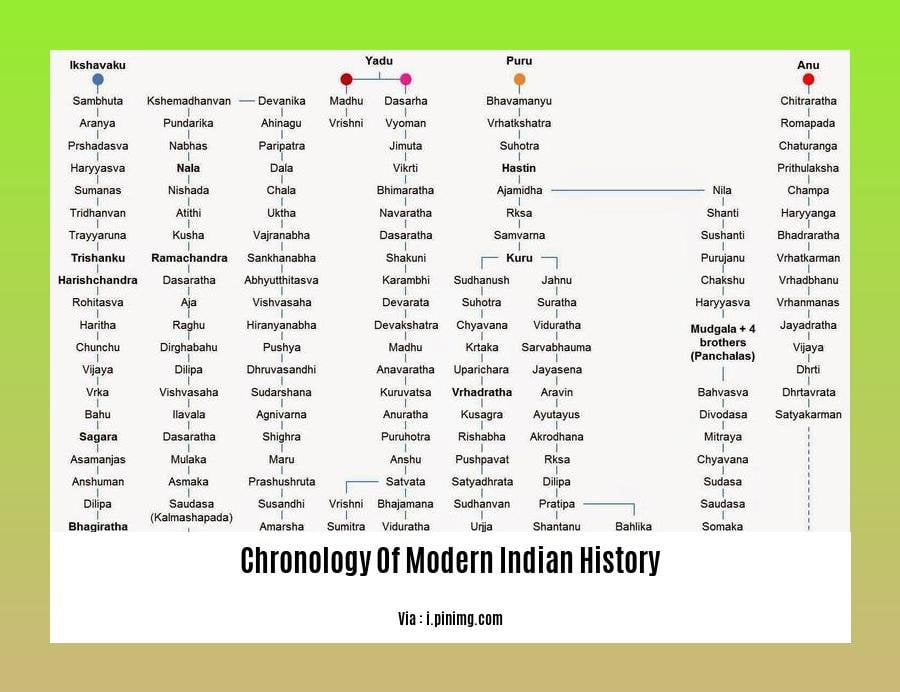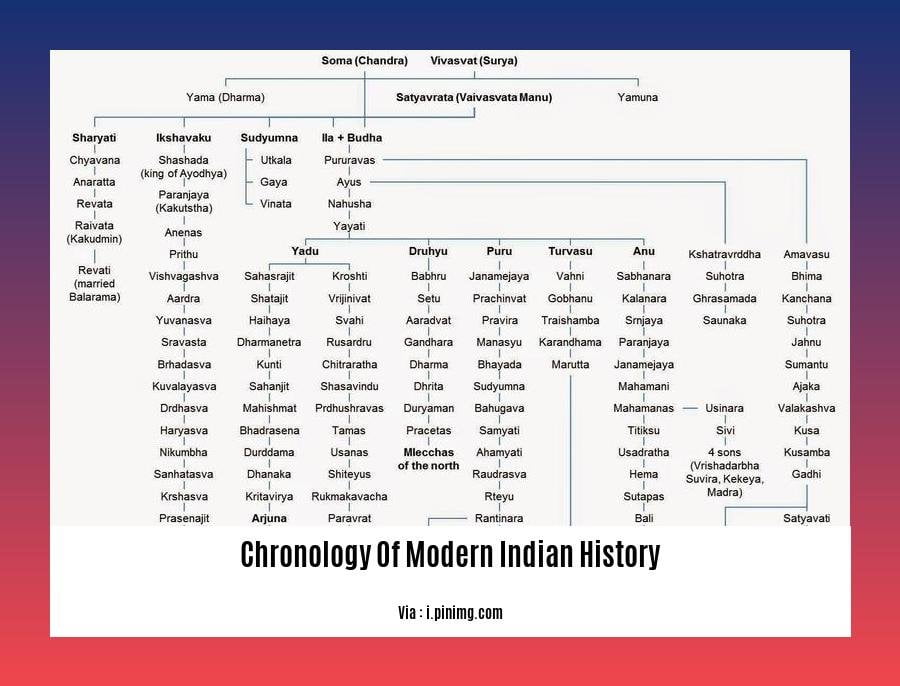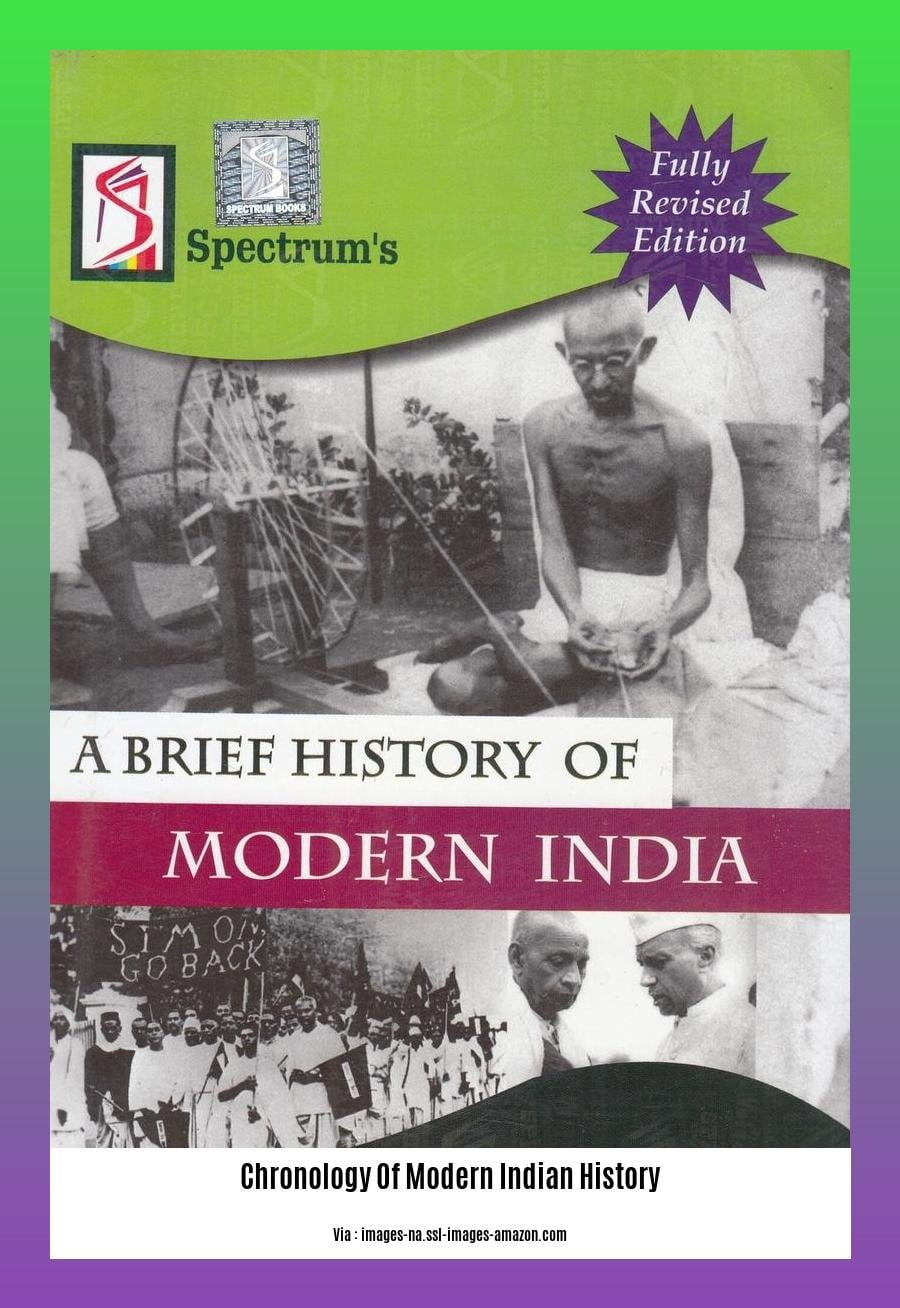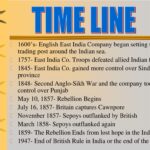Dive into the captivating journey of modern India in our comprehensive article, “Chronology of Modern Indian History: A Comprehensive Overview of India’s Transformation.” Discover the rich tapestry of events, influential figures, and transformative movements that have shaped the nation’s destiny. From the dawn of British rule to the exhilarating era of independence and beyond, we explore the pivotal moments that have propelled India to its current position as a global powerhouse. Get ready to embark on an enlightening voyage through the annals of modern Indian history!
Key Takeaways:
1707: Mughal Emperor Aurangzeb’s death left the empire in disarray.
1761: Third Battle of Panipat: The Marathas were defeated by Ahmad Shah Abdali.
1764: Battle of Buxar: The British East India Company defeated the combined forces of Mir Qasim, the Nawab of Oudh, and the Mughal Emperor Shah Alam II.
1765: Diwani of Bengal, Bihar, and Orissa was obtained by the British East India Company.
1772: Warren Hastings became the first Governor-General of Bengal.
1784: The Pitt’s India Act established a Board of Control to oversee the affairs of the British East India Company.
1799: The Fourth Anglo-Mysore War ended with the defeat of Tipu Sultan.
1803: The Second Anglo-Maratha War resulted in the annexation of Maratha territories by the British.
1818: The Third Anglo-Maratha War led to the British annexation of the remaining Maratha territories.
1833: The Charter Act of 1833 lifted the East India Company’s trade monopoly, allowing Indians in the company’s administration.
1857: The Indian Rebellion (Sepoy Mutiny) challenged British rule in India.
1858: The Government of India Act transferred India’s rule from the East India Company to the British Crown.
1885: The Indian National Congress (INC) was formed by A.O. Hume.
1906: The Muslim League was established by Sir Syed Ahmed Khan.
Chronology of Modern Indian History


From the Mughal Empire’s decline to the rise of the Indian National Congress, modern Indian history is a chronicle of empires, revolutions, and the struggle for independence. Let’s delve into this transformative era:
The Mughal Empire’s Decline:
1707: Mughal Emperor Aurangzeb’s death marked the beginning of the empire’s disintegration, leading to regional power struggles.
1761: The Marathas were defeated by Ahmad Shah Abdali at the Third Battle of Panipat, weakening their dominance in central India.
British East India Company’s Ascendance:
1764: The British East India Company’s victory at the Battle of Buxar cemented their control over Bengal.
1765: The Company secured the Diwani of Bengal, granting them revenue collection rights, solidifying their economic foothold.
Emergence of Indian Nationalism:
1857: The Indian Rebellion of 1857, also known as the Sepoy Mutiny, marked the first widespread uprising against British rule.
1885: The Indian National Congress (INC) was founded by A.O. Hume, becoming a prominent voice for Indian self-governance.
Towards Independence:
1906: The Muslim League was founded by Sir Syed Ahmed Khan, representing the political aspirations of Indian Muslims.
1919: The Rowlatt Act sparked widespread protests, leading to the Jallianwala Bagh massacre and intensifying the independence movement.
1930: Mahatma Gandhi launched the Civil Disobedience Movement, advocating nonviolent resistance against British rule.
1942: The Quit India Movement, led by Gandhi, called for complete independence from British rule.
Partition and Independence:
1947: India gained independence from British rule, but the country was partitioned into India and Pakistan, leading to mass migrations and communal violence.
1948: Mahatma Gandhi was assassinated by Nathuram Godse, a Hindu nationalist, for his support of a united India.
Conclusion:
The chronology of modern Indian history is a saga of political upheavals, social transformations, and the indomitable spirit of a nation yearning for freedom. The legacies of this era continue to shape contemporary India’s political, social, and cultural landscape.
- Discover the captivating history of clothing in India, delving into the evolution of traditional attire and the influence of cultural diversity throughout the centuries. clothing in india history
- Immerse yourself in the dynamic world of contemporary dance, exploring its captivating history, influential pioneers, and the evolution of expressive movements that continue to shape the art form. contemporary dance history
- Journey through time as you explore the comprehensive timeline of early church history, unraveling pivotal events, significant figures, and the formative influences that shaped the development of Christianity. early church history timeline
Chronology of Modern Indian History: A Comprehensive Overview of India’s Transformation
Key Takeaways:
Modern Indian history, spanning 1707 to 1947, witnessed significant events that transformed the nation.
The Mughal Empire weakened after Emperor Aurangzeb’s death in 1707, paving the way for the rise of regional powers and the eventual British presence.
The British East India Company systematically expanded its influence, entrenching its power through battles like Buxar (1764) and economic policies like the Diwani of Bengal (1765).
The 1857 Sepoy Mutiny, also known as the First War of Independence, showcased Indian resentment against British rule, leading to administrative changes.
The Indian National Congress, established in 1885, played a crucial role in the independence movement, advocating for self-governance and opposing British policies.
The 20th century saw the rise of Mahatma Gandhi’s nonviolent resistance movement, influencing the Indian masses and contributing to India’s eventual independence in 1947.
Major Eras of Modern Indian History:
- Mughal Decline and the Rise of Regional Powers (1707-1764):
The Mughal Empire’s weakening after Aurangzeb’s death led to the emergence of regional powers like the Marathas and the Nawabs of Bengal.
- The British East India Company’s Dominance (1764-1857):
The Battle of Buxar (1764) solidified the British East India Company’s control over Bengal, marking the beginning of their colonial rule in India.
- The Sepoy Mutiny and its Aftermath (1857-1885):
The 1857 Sepoy Mutiny, driven by Indian resentment against British rule, resulted in the transfer of power from the East India Company to the British Crown.
- The Rise of the Indian National Congress (1885-1947):
The Indian National Congress, led by prominent figures like Mahatma Gandhi, emerged as the primary advocate for Indian independence through nonviolent resistance.
- The Nonviolent Resistance Movement and Independence (1920-1947):
Mahatma Gandhi’s philosophy of nonviolent resistance, or Satyagraha, influenced millions of Indians, leading to the country’s independence from British rule in 1947.
Conclusion:
The chronology of modern Indian history upsc is a testament to the nation’s resilience, struggle, and transformation. From the decline of the Mughals to the rise of the British Empire, the Indian National Congress’s freedom movement, and Mahatma Gandhi’s leadership, India’s journey to independence is a story of unity, courage, and determination. Understanding this chronology of modern indian history upsc is essential for comprehending the factors that shaped contemporary India.
Sources:
Timeline of Indian History – Modern India (1707-1947)
FAQ
Q1: What is the significance of the Battle of Buxar in Indian history?
A1: The Battle of Buxar in 1764 marked a decisive victory for the British East India Company, consolidating their control over Bengal and Bihar, and effectively ending the Mughal Empire’s influence in the region.
Q2: Who was the first Governor-General of Bengal?
A2: Warren Hastings was appointed as the first Governor-General of Bengal in 1772, marking the formal beginning of the British Raj in India.
Q3: What impact did the Charter Act of 1833 have on Indian administration?
A3: The Charter Act of 1833 introduced significant reforms in the governance of India, abolishing the East India Company’s monopoly on trade, allowing Indians to hold positions in the Company’s administration, and paving the way for the introduction of Western education in India.
Q4: What was the primary reason for the Indian Rebellion of 1857?
A4: The Indian Rebellion of 1857, also known as the Sepoy Mutiny, was triggered by various factors, including discontent among Indian soldiers (sepoys) over religious and cultural issues, resentment against British rule, and the introduction of new technologies that threatened traditional societal structures.
Q5: What was the significance of the formation of the Indian National Congress (INC)?
A5: The Indian National Congress, founded in 1885, played a pivotal role in the Indian independence movement. It provided a platform for national leaders to unite, mobilize, and articulate the demands for self-governance and eventually played a crucial part in achieving India’s independence from British rule.
- SYBAU See You Baby Meaning: Gen Z Slang Evolves - July 1, 2025
- Unlock Your Inner Youth: Lifestyle Secrets for a Vibrant Life - July 1, 2025
- Decode SYBAU Meaning: Gen Z Slang Explained - July 1, 2025






